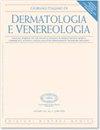A retrospective study on clinical subtypes and management of morphea in 10 Italian Dermatological Units.
IF 2
Q3 Medicine
Giornale Italiano Di Dermatologia E Venereologia
Pub Date : 2020-10-16
DOI:10.23736/S0392-0488.20.06632-8
引用次数: 1
Abstract
BACKGROUND There are still few dermatological studies on morphea. We evaluated the epidemiological and clinical features and management of pediatric morphea, reporting dermatologists experience. METHODS A multicentre retrospective observational study was carried out on the epidemiological and clinical features and management of the disease between 01/01/2009 and 01/10/2014 in 10 Italian Dermatological Units. RESULTS We collected the data of 69 children affected by: circumscribed morphea (39.1%); linear morphea of trunk and limbs (14.5%); en coupe de sabre morphea (ECDS) (14.5%); progressive facial hemiatrophy (8.7%); generalized form (18.8%); mixed morphea (4.4%). The mean age at onset was 6.86±3.21 years, mainly between 2 and 8 years, but is statistically significantly lower for ECDS (4.5±3.03). Localizations were: head/neck (30.4%), limbs (26.1%), trunk (14.5%), 2 or more sites (29%), most often the trunk plus limbs. Extracutaneous manifestations were observed in 26.1% patients. 10 patients presented a second autoimmune disorder. Treatments were topical in 26.1% cases and systemic (alone or associated with topical treatments) in 68.1%. CONCLUSIONS There was a lack of uniformity in the management of patients and an increasing awareness of dermatologists on the use of systemic therapies, in particular of methotrexate, which is no longer exclusive to rheumatologists. Methotrexate causes stabilization and improvement of the clinical signs, but topical creams are still considered adjuvant or maintenance therapies during/after the use of systemic drugs.意大利10个皮肤科单位morphea临床亚型及治疗回顾性研究。
关于吗啡的皮肤病学研究仍然很少。我们评估了流行病学和临床特征以及儿科吗啡的处理,报告了皮肤科医生的经验。方法对意大利10家皮肤科2009年1月1日至2014年10月1日收治的该病流行病学、临床特征及治疗进行多中心回顾性观察研究。结果我们收集了69例儿童的数据:局限性吗啡中毒(39.1%);躯干和四肢线形分布(14.5%);剑齿炎双发(ECDS) (14.5%);进行性面部偏瘫(8.7%);广义型(18.8%);混合性吗啡(4.4%)。平均发病年龄为6.86±3.21岁,主要在2 ~ 8岁之间,但ECDS的平均发病年龄(4.5±3.03)有统计学意义。定位部位为头颈部(30.4%)、四肢(26.1%)、躯干(14.5%)、2个及以上(29%),以躯干加四肢多见。26.1%的患者有皮肤外表现。10例患者出现第二种自身免疫性疾病。局部治疗占26.1%,全身(单独或联合局部治疗)占68.1%。结论:患者管理缺乏统一性,皮肤科医生对使用全身治疗的认识日益提高,特别是甲氨蝶呤,这不再是风湿病医生的专属。甲氨蝶呤可以稳定和改善临床症状,但局部乳霜仍被认为是全身用药期间/之后的辅助或维持治疗。
本文章由计算机程序翻译,如有差异,请以英文原文为准。
求助全文
约1分钟内获得全文
求助全文
来源期刊

Giornale Italiano Di Dermatologia E Venereologia
DERMATOLOGY-
CiteScore
1.90
自引率
0.00%
发文量
0
审稿时长
6-12 weeks
期刊介绍:
The journal Giornale Italiano di Dermatologia e Venereologia publishes scientific papers on dermatology and sexually transmitted diseases. Manuscripts may be submitted in the form of editorials, original articles, review articles, case reports, therapeutical notes, special articles and letters to the Editor.
Manuscripts are expected to comply with the instructions to authors which conform to the Uniform Requirements for Manuscripts Submitted to Biomedical Editors by the International Committee of Medical Journal Editors (www.icmje.org). Articles not conforming to international standards will not be considered for acceptance.
 求助内容:
求助内容: 应助结果提醒方式:
应助结果提醒方式:


